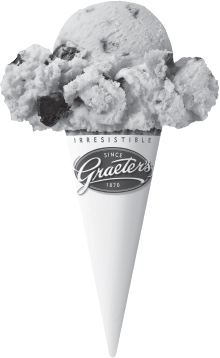Greater's Ice Cream
Read Greater's Ice Cream Online
Authors: Robin Davis Heigel
Tags: #Graeter’s Ice Cream: An Irresistible History




ROBIN DAVIS HEIGEL

Published by The History Press
Charleston, SC 29403
www.historypress.net
Copyright © 2010 by Robin Davis Heigel
All rights reserved
First published 2010
e-book edition 2011
ISBN 978.1.61423.071.7
Library of Congress Cataloging-in-Publication Data
Heigel, Robin Davis.
Graeter's Ice Cream : an irresistible history / Robin Davis Heigel.
p. cm.
Includes bibliographical references and index.
print edition: ISBN 978-1-59629-971-9
1. Graeter's (Firm)--History. 2. Ice cream industry--United States--History. 3.
Ice cream parlors--Ohio--Cincinnati--History I. Title.
HD9281.U54G734 2010
338.7'63740973--dc22
2010019124
Notice
: The information in this book is true and complete to the best of our knowledge. It is offered without guarantee on the part of the author or The History Press. The author and The History Press disclaim all liability in connection with the use of this book.
All rights reserved. No part of this book may be reproduced or transmitted in any form whatsoever without prior written permission from the publisher except in the case of brief quotations embodied in critical articles and reviews.
Foreword, by Richard Graeter II
Acknowledgements
Introduction
The Early Years
A Changing Country, an Uneasy Alliance
Third Generation
Tough Transition
Looking to the Future
Accolades
Timeline
Store Locations
Bibliography
Index
About the Author
FOREWORD
The ancient Greek tragedians taught that only through suffering can one gain wisdom. Perhaps this is why most family businesses do not make it to the fourth generation. The succeeding generations, thanks to the hard work of the prior ones, do not have to work so hard to enjoy the good life, and so they lose the entrepreneurial zeal and dedication that gives all great family businesses an edge over their big-business competition. In such cases, the latter generations eventually run down their legacy or sell outâusually both. Thankfully, my family has steadfastly been able to avoid this fate. So maybe a little suffering is not such a bad thing! I guess that makes yet one more thing I owe to my father. Thanks, Dad!
As every family business consultant and advice book will tell you, the most dangerous and painful road that all family businesses must negotiate is transitioning from one generation to the next. My family has certainly had its share of pain during its transitions over the years. An untimely death, an irreconcilable feud between brothers, a debilitating accident, bickering cousins and a near-death experienceâall these and more marked the transitions of one generation to another for the Graeter family.
And yet through it all, we have survived and come out stronger, I think, thanks to the one shared value that we all hold dear above all other things: the quality of our product, Graeter's Ice Cream. Over the years, the family has probably disagreed on everything under the sun. But we have never disagreed on our dedication to quality. And that has been the glue that has kept us together for over 140 years.
When asked if I regret the struggle with the difficult transition to our generation, I reply that I do not. Had it been easy, then perhaps my cousins and I would not have the strong partnership that we now enjoy. It has been said that such bonds form among those who share a traumatic experience. We certainly had our share of trauma trying to figure out how to move to the fourth generation, but I can honestly say that the relationship among us, and with our aunt and fathers, has never been stronger. The ancients were right: wisdom comes through suffering. May heaven help the upcoming fifth generation!
What follows is a story about our family, our business and, most importantly, our ice cream. We have seen many changes over the years and have made many changes, but we have never sacrificed on our core promise: to simply make the best ice cream that you'll ever taste. Readers of bestselling business author (and my personal favorite) Jim Collins will readily understand this precept.
At one time, everyone made ice cream the way we do. Now, we are the only ones left. Why? Because we always understood that we must never change the product, a fact that liberated us to make other changes necessary to survive through fourteen decades.
The other reason we're the only ones still making ice cream the old-fashioned way? Because the Graeter family is just that darn stubborn.
Richard A. Graeter II
President and CEO of Graeter's Inc.and
Graeter's Manufacturing Company
Fourth generation of Graeter family
I created this book primarily from interviews with the Graeter family. Dick, Lou and Kathy gave me their recollections of their father, grandfather and the earliest years of the business, while Richard and Chip detailed what it was like to grow up as a Graeter and the difficult transition to becoming the owners of the company. I supplemented the family information with historical information from books, newspapers and magazine articles and various online sources, including
timeline.org
, as noted in the bibliography.
My thanks go out to the Graeter family for being so open with me about their family history and for helping me piece together the different eras. Thanks especially to Richard, who went through the manuscript carefully to make sure the details I had collected from so many different sources were correct.
I would also like to thank Joe Gartrell and The History Press for the opportunity to write this book.
To my friends and family, thank you for accompanying me on multiple trips to Graeter's Ice Cream every time I
needed a break from research and writing to get some sweet inspiration. I know it was a sacrifice. I wish my jeans had been as accommodating as all of you.
And I would like to offer a special thank-you to my family. Ben, thanks for being understanding when I needed to miss so many of your tennis matches to finish the book. Molly and Sarah, thanks for putting up with so many nights of “graband-go” dinners.
I would also like to give my biggest thanks to my husband, Ken, for his photographic contributions to the book, for careful and kind editing of the words and for his constant encouragement.
Historians do not agree on when or where ice cream was created, but the general consensus is that it was invented in China in the form of sweet ice, possibly as early as 3000 BC. Centuries later, Marco Polo discovered it on his world travels, and he then supposedly took the treat back to Italy, where it was made into something closer to what we now call “ice cream.”
While this can't be confirmed or denied, it is certain that the ice cream enjoyed in the United States today came from Europe. Thomas Jefferson, who ate ice cream in France, is credited with making it popular in America. The Jefferson Papers Collection at the Library of Congress houses one of the first printed recipes for ice cream, from 1784. It calls simply for cream, sugar and eggs and was made using a machine called the sabottiere or sorbetiere, which looks like a primitive version of today's hand-cranked ice cream makers.
From there, ice cream became the darling of anyone who had some version of a maker and access to ice. The rich treat
had to be cranked and enjoyed right away, because without refrigerators or freezers, there was no means of storing it frozen for any length of time.
In the late 1800s in Cincinnati, Ohio, Louis Charles Graeter turned to ice cream to make a living. He cranked the ice cream in the back room of the bottom floor of his home on McMillan Street and sold it out the front. He used what was known as the “French pot,” a spinning bowl that would throw the sweet mixture against the sides, from where he scraped it as it froze, not much different than the early sabottieire.
Now, almost 150 years later, an ice cream produced by the fourth generation of the Graeter familyâin virtually the same mannerâis considered by many to be one of the best ice creams in the country. It has gained national notoriety, being highlighted in
O!
magazine and featured in other publications such as
Gourmet
,
Vanity Fair
and
Saveur
. Mystery writer James Patterson included Graeter's Ice Cream in one of his thrillers,
Honeymoon
, in 2005.
Ohio senator Gary Cates used Graeter's Ice Cream to sweeten the pot, so to speak, feeding it to other senators in order to get a bill on workman's compensation passed in 2005. “I found that people are a lot friendlier when they're eating Graeter's Ice Cream,” Cates said in an article in the
Columbus Dispatch
.
In Ohio, Graeter's Ice Cream represents such a part of the fabric of life that it is not uncommon to find obituaries that list the ice cream among the favorite things of the deceased, along with the Cincinnati Reds and the Ohio State Buckeyes.
Graeter's Ice Cream is no ordinary ice cream, though the flavors certainly sound familiar and it can be found somewhere as ordinary as a supermarket freezer in certain parts of the country. Graeter's is more than just a pleasant regional ice cream, like Pierre's of Cleveland with its dozens of flavors or Velvet Ice Cream of Utica, Ohio, even though Velvet is also
family owned and almost as old as Graeter's. And Graeter's is different than the new breed of artisan ice creams, such as Jeni's Splendid Ice Creams in Columbus, with its far-out flavors. The flavors at Graeter's have changed little in the last seventy-five years.
Graeter's is, by and large, exactly the same as it was when Louis Charles hand stirred it in the original French pots. There's a lot to be said for a product that has maintained such consistency and such a loyal following for that length of time. And the company is still 100 percent family owned, no small feat considering that less than 3 percent of family businesses survive into the fourth generation.
